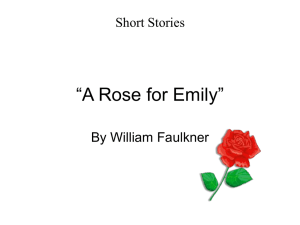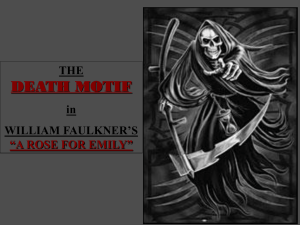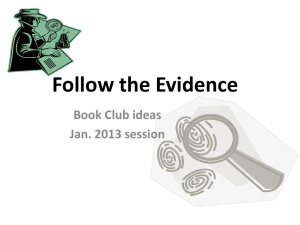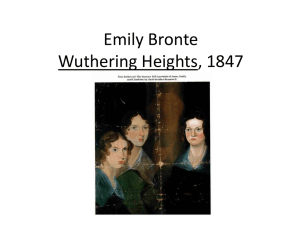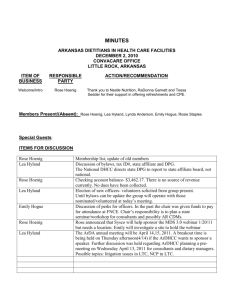What makes your SKIN CRAWL?
advertisement
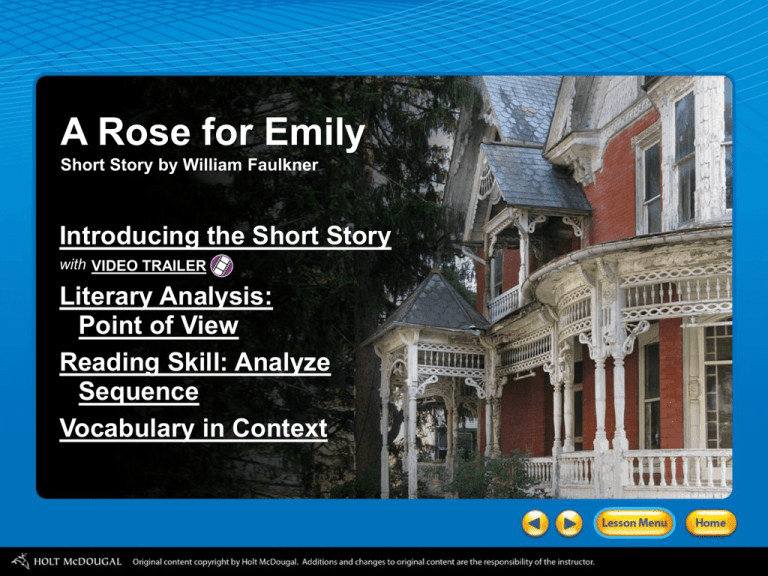
A Rose for Emily Short Story by William Faulkner Introducing the Short Story with VIDEO TRAILER Literary Analysis: Point of View Reading Skill: Analyze Sequence Vocabulary in Context A Rose for Emily INTRODUCING THE SHORT STORY What makes your SKIN CRAWL? As the girl steps outside into the alley, the overpowering smell of rotting garbage assaults her nostrils. Her stomach turns as she tries not to stare at a mass of maggots eating a discarded hamburger, and she shies away from the dumpster, with its squeaking and squirming inhabitants. Certain scenes from books or movies are so evocative that they leave you shaky and nauseated. A Rose for Emily INTRODUCING THE SHORT STORY What makes your SKIN CRAWL? Part of what you’re responding to is the creepy atmosphere the writers or directors have created to mesmerize and repulse you. A Rose for Emily INTRODUCING THE SHORT STORY What makes your SKIN CRAWL? DISCUSS In a small group, talk about the one thing that really gives you the creeps. Spiders, rats, the sight of blood—do any of these make your skin crawl? What movies or books have used these things to create an atmosphere that makes you shudder? Which works top your “creepiness scale”? Record the responses of your group to share with others. A Rose for Emily Click on the title to play the trailer. A Rose for Emily A Rose for Emily Point of View As you’ve already learned, Faulkner is a pioneer of modernist fiction. He uses stream of consciousness, mimicking the flow of a character’s thoughts and sensations to convey the subjective nature of experience. He uses multiple narrators, taking the point of view of several characters in a single novel. William Faulkner A Rose for Emily Point of View With each work of fiction, he crafts a point of view uniquely suited to the story being told. “A Rose for Emily” is the story of a small town’s struggle to understand one of its residents. A Rose for Emily Point of View Using multiple narrators would be difficult in a short story. Using stream of consciousness would not convey what is most important here—the public perception of Miss Emily. Faulkner’s choice for point of view, then, is first-person plural—an unnamed we, the voice of the townspeople themselves. A Rose for Emily Point of View As you read, notice the narrator’s use of first-person pronouns such as we and our. What role does this point of view play in your understanding of Miss Emily and her story? How might other points of view change the narrative? A Rose for Emily Analyze Sequence Faulkner often rearranges the sequence of events in his fiction, using flashbacks to offer a window into a character’s past or dropping hints that foreshadow what is yet to come. A Rose for Emily Analyze Sequence As you read, keep a chart like the one shown. In the left column, record the story’s events as you read about them. When you finish the story, number the events in chronological order. Order in Which Narrator Reveals Events Order in Which Events Occur 1. Miss Emily dies. 8 2. The aldermen visit about taxes. 7 A Rose for Emily cabal Faulkner uses the vocabulary words in the box on the right to create a story rich with atmosphere. Try to define each, based on its context. Sample answers appear in brackets. imperviousness tableau temerity 1. The cabal executed their shady plans in secret. [group united in a secret plot] 2. The swaggering boy approached him with temerity. [foolish boldness] 3. Moonlight made the rickety house into a terrifying tableau. [scene] 4. Her imperviousness made her impossible to frighten. [inability to be affected] A Rose for Emily cabal n. a group united in a secret plot imperviousness n. condition of not being able to be affected or disturbed tableau n. a dramatic scene or picture temerity n. foolish boldness
